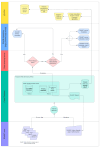The Rapid Assessment of Avoidable Blindness survey: Review of the methodology and protocol for the seventh version (RAAB7)
- PMID: 38828387
- PMCID: PMC11143406
- DOI: 10.12688/wellcomeopenres.20907.1
The Rapid Assessment of Avoidable Blindness survey: Review of the methodology and protocol for the seventh version (RAAB7)
Abstract
The Rapid Assessment of Avoidable Blindness (RAAB) is a population-based cross-sectional survey methodology used to collect data on the prevalence of vision impairment and its causes and eye care service indicators among the population 50 years and older. RAAB has been used for over 20 years with modifications to the protocol over time reflected in changing version numbers; this paper describes the latest version of the methodology-RAAB7. RAAB7 is a collaborative project between the International Centre for Eye Health and Peek Vision with guidance from a steering group of global eye health stakeholders. We have fully digitised RAAB, allowing for fast, accurate and secure data collection. A bespoke Android mobile application automatically synchronises data to a secure Amazon Web Services virtual private cloud when devices are online so users can monitor data collection in real-time. Vision is screened using Peek Vision's digital visual acuity test for mobile devices and uncorrected, corrected and pinhole visual acuity are collected. An optional module on Disability is available. We have rebuilt the RAAB data repository as the end point of RAAB7's digital data workflow, including a front-end website to access the past 20 years of RAAB surveys worldwide. This website ( https://www.raab.world) hosts open access RAAB data to support the advocacy and research efforts of the global eye health community. Active research sub-projects are finalising three new components in 2024-2025: 1) Near vision screening to address data gaps on near vision impairment and effective refractive error coverage; 2) an optional Health Economics module to assess the affordability of eye care services and productivity losses associated with vision impairment; 3) an optional Health Systems data collection module to support RAAB's primary aim to inform eye health service planning by supporting users to integrate eye care facility data with population data.
Keywords: Vision impairment; blindness; cataract; data repository; effective coverage; mobile data collection; open data; population survey.
Plain language summary
In 2020 there were an estimated 1.1 billion people with vision impairment globally. Vision impairment negatively affects people’s quality of life, social inclusion and productivity. The Rapid Assessment of Avoidable Blindness (RAAB) survey tool collects information about the vision and eye health of people aged 50 years and older in a defined population. It has been used worldwide for over 20 years to inform eye health service planning. This paper outlines the current survey methodology and summarises recent and upcoming developments. The RAAB project team has updated the survey to allow users to measure vision and collect other information on mobile devices (telephones or tablets) and send the findings directly to a central computer for automated analysis. The project team has built a new website to store this information and to allow anyone interested to find out more about the surveys done to date. The RAAB project continues to develop new features to make the information collected in surveys more useful for eye health service planning and eye health advocacy.
Copyright: © 2024 McCormick I et al.
Conflict of interest statement
No competing interests were disclosed.
Figures



Similar articles
-
Changing trends of blindness, visual impairment and cataract surgery in Bhutan: 2009-2018.PLoS One. 2019 May 9;14(5):e0216398. doi: 10.1371/journal.pone.0216398. eCollection 2019. PLoS One. 2019. PMID: 31071127 Free PMC article. Clinical Trial.
-
Assessment of eye health programme reach by comparison with rapid assessment of avoidable blindness (RAAB) survey data, Talagang, Pakistan.BMC Prim Care. 2024 Jul 10;25(1):250. doi: 10.1186/s12875-024-02503-4. BMC Prim Care. 2024. PMID: 38987673 Free PMC article.
-
Nationwide Rapid Assessment of Avoidable Blindness (RAAB) in Armenia.Ophthalmic Epidemiol. 2024 Feb;31(1):62-69. doi: 10.1080/09286586.2023.2187068. Epub 2023 Mar 5. Ophthalmic Epidemiol. 2024. PMID: 36872562
-
Rapid Assessment of Avoidable Blindness: looking back, looking forward.Br J Ophthalmol. 2019 Nov;103(11):1549-1552. doi: 10.1136/bjophthalmol-2019-314015. Epub 2019 Jul 2. Br J Ophthalmol. 2019. PMID: 31266777 Free PMC article. Review.
-
Causes of blindness and vision impairment in 2020 and trends over 30 years, and prevalence of avoidable blindness in relation to VISION 2020: the Right to Sight: an analysis for the Global Burden of Disease Study.Lancet Glob Health. 2021 Feb;9(2):e144-e160. doi: 10.1016/S2214-109X(20)30489-7. Epub 2020 Dec 1. Lancet Glob Health. 2021. PMID: 33275949 Free PMC article.
Cited by
-
Prevalence and causes of blindness and vision impairment among people 50 years and older in Nepal: A national Rapid Assessment of Avoidable Blindness survey.PLoS One. 2025 Feb 13;20(2):e0309037. doi: 10.1371/journal.pone.0309037. eCollection 2025. PLoS One. 2025. PMID: 39946351 Free PMC article.
-
Effective cataract surgical and refractive error coverages in the state of Qatar.BMC Ophthalmol. 2025 Feb 25;25(1):96. doi: 10.1186/s12886-025-03915-1. BMC Ophthalmol. 2025. PMID: 40000984 Free PMC article.
-
Global burden of vision impairment due to age-related macular degeneration, 1990-2021, with forecasts to 2050: a systematic analysis for the Global Burden of Disease Study 2021.Lancet Glob Health. 2025 Jul;13(7):e1175-e1190. doi: 10.1016/S2214-109X(25)00143-3. Lancet Glob Health. 2025. PMID: 40580986 Free PMC article.
-
Awareness of Common Ocular Conditions Among Trinidad Population: A Cross-Sectional Pilot Study.Health Sci Rep. 2025 Mar 24;8(3):e70603. doi: 10.1002/hsr2.70603. eCollection 2025 Mar. Health Sci Rep. 2025. PMID: 40135077 Free PMC article.
-
Prevalence of vision impairment, diabetic retinopathy and disability in adults 50+ in the occupied Palestinian territories.PLOS Glob Public Health. 2024 Sep 26;4(9):e0003613. doi: 10.1371/journal.pgph.0003613. eCollection 2024. PLOS Glob Public Health. 2024. PMID: 39325759 Free PMC article.
References
-
- Limburg H: Rapid assessment of cataract surgical services.2001. Reference Source
LinkOut - more resources
Full Text Sources
Miscellaneous

